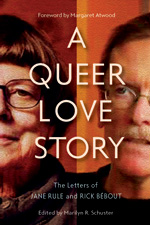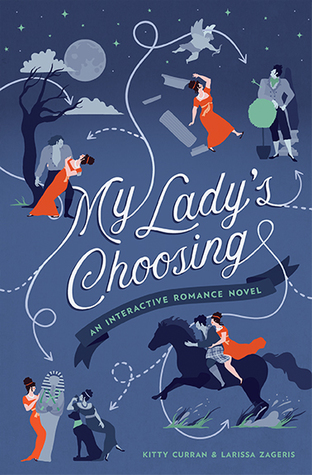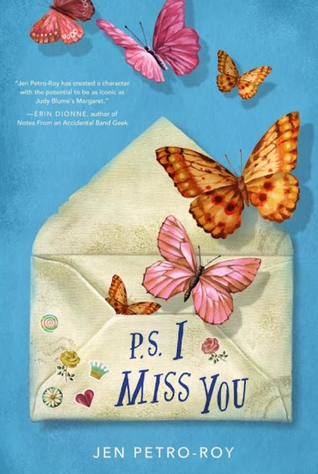“I expect our letters to be someday public property, and, though I write with little self-consciousness about being overheard at some future date, talking intermittently to you and to myself, it seems to me what has concerned us is richly human and significantly focused on the concerns of our time and our tribe.” – Jane Rule to Rick Bébout, August 2, 1989 (Intro, xiii)
Some of the most powerful love stories occur between friends. I have always longed for a bosom buddy, someone who would stand by my side fending off the zombie apocalypse and navigating ethical dilemmas. A Queer Love Story: The Letters of Jane Rule and Rick Bébout edited by Marilyn R. Schuster, presents fourteen years (1981-1995) of correspondence between Jane Rule to Rick Bébout, two such friends. Margaret Atwood, a longtime friend of Jane and her partner, Helen Sonthoff, penned the foreword and is mentioned with affection in the letters.
Jane Rule (1931-2007) was an author and social commentator, a tidy summation of the innumerable roles and contributions she made to the Arts and LGBT+ community. Among her novels, she is perhaps best known for her 1964 romance, The Desert of the Heart (later produced as the 1985 film, Desert Hearts). Rule emigrated with Sonthoff from the United States in the 1950s and made their home in Galiano, British Columbia.
Rick Bébout (1950-2009) wrote prolifically for The Body Politic (TBP) (a Toronto-based publication written for LGBT+ readers, on social issues and culture) and contributed to other publications, as well; tirelessly advocated for the rights and respect of queer folks. He assembled through AIDS education materials for the AIDS Committee of Toronto (ACT) and the Hassle Free Clinic, among others. A fellow American expatriate, Bébout moved to Canada during the Vietnam War and later gained Canadian citizenship.
Rule’s and Bébout’s relationship began as that of writer and editor, when she submitted articles and pieces for her column, “So’s Your Grandmother”, to TBP. As managing editor, Bébout lived and breathed the magazine; the ebb and flow of his life was dictated by the publication cycle. He juggled multiple hats and personalities at TBP. Over the years, a deep friendship developed. Topics they discussed run the gamut, including racism, same-sex marriage, violence against women, freedom of expression, and the effect of fantasy on behavior.
Rule and Bébout weathered the heartbreaks of losing friends to AIDS, the frustration in fighting for equal dissemination of health information and access to health care, career changes, and more. They offered strength, solace, and safe space. More than once, Rule and Sonthoff bought Bébout round-trip plane tickets to Galiano Island, where he could relax at their home and elsewhere on the West Coast of Canada. Subtle clues about the evolution of their relationship manifests in subtle ways, such as how they sign-off their letters. The transition of Rick’s sign-offs from the semi-formal “sincerely” (1981) to the more companionable “love” (1985), for example, shows a shift of sentiment.
It’s not only the sweeping scope of events and issues, but the more mundane, everyday pleasures of life, that draw me into their story: Helen and Jane reading aloud to each other at night; swimming at a community pool; and Rick meeting and making friends at gay bars in Toronto. Between the two writers, they show the joys and challenges of rural and city lives.
“We die bravely and well, so many of us, giving all the way to the end – and those of us left mourning hold to that and cherish it and grow from it. But dammit, the end is too soon, and children born today will never know things they might have known if the end were not so soon for so many of us. That’s my rage, that’s what my grief is for: what’s lost.” —Rick Bébout, 1988 (Introduction, xxv).
Rule and Bébout were cognizant of the potential posterity of their letters, given their high visibility within the Arts and LGBT+ community. When Schuster approached them with her idea of publishing the letters, they not only approved, but facilitated access to materials in various formats. Headnotes and endnotes for each chapter (how I refer to sections encompassing a calendar year) enrich the two friends’ discussions. A “Dramatis Personae” section details persons of note found in the letters. It is also worth noting the immensity of Schuster’s project. Her skilled editing chiseled 2,700 pages of correspondence into a coherent and engaging volume representing twenty-five percent of the original total.
It is a pleasure and a privilege to “watch” their friendship grow. I highly recommend A Queer Love Story for folks interested in LGBT+ history and fans of Jane rule, in particular. If you want to learn more about Jane Rule and view her through the autobiographical lens, check out her posthumously published memoir, Taking My Life (2011), reviewed last year by Casey the Canadian Lesbrarian. You can learn more about Rick Bébout via his website, http://www.rbebout.com/. A Queer Love Story: The Letters of Jane Rule and Rick Bébout is available for purchase on May 1, 2017.
Page numbers refer to the uncorrected proof received from the University of British Columbia Press and are subject to change at time of publication.
You can read more of Julie’s reviews on her blog, Omnivore Bibliosaur (jthompsonian.wordpress.com)



